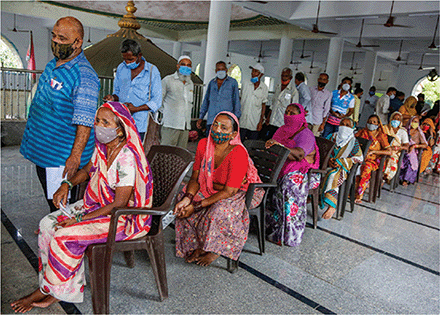Science‘s COVID-19 reporting is supported by the Heising-Simons Foundation
COVID-19 doesn’t strike the genders equally. Globally, for every 10 COVID-19 intensive care unit admissions among women, there are 18 for men; for every 10 women who die of COVID-19, 15 men die. In the United States, a gender gap is emerging in vaccination rates, with women ahead of men by 6 percentage points, according to the Centers for Disease Control and Prevention. And rare adverse effects from the AstraZeneca vaccine appear to strike women more frequently, whereas those from the Pfizer-BioNTech and Moderna vaccines more often affect young men.
But out of 45 COVID-19 randomized controlled trials whose results were published by December 2020, only eight reported the impact of sex or gender, according to a paper published this week in Nature Communications. Other recent data show even simple counts of cases and vaccinations are not broken down by sex and gender.
Senior author Sabine Oertelt-Prigione, a gender and health researcher at Radboud University Medical Center, was disheartened by her group’s findings. “I would have assumed that [sex] would be picked up in the trials, simply because it’s such an evident piece of the puzzle,” she says. Skipping that step is potentially dangerous in trials of drugs that may affect men and women differently, given their physiological differences, Oertelt-Prigione says. And it misses an opportunity to learn about the workings of the disease, adds Susan Phillips, an epidemiologist at Queen’s University who was not involved in the study.
Martin Landray of the University of Oxford finds the lack of attention to sex effects surprising, too. He led the United Kingdom’s Recovery trial, which found the anti-inflammatory drug tocilizumab reduces risk of death from COVID-19, and which did explore results by sex (though it found none worth highlighting). “I just thought that’s what everybody did.” But Phillips notes that researchers have often skipped gender analyses in published clinical research for more than 30 years. “The problem remains,” she says. “And this makes the current paper important.”
Oertelt-Prigione’s team searched PubMed for all papers on COVID-19 published before December 15 2020, excluding commentaries, observational trials, and other studies to identify 45 randomized controlled trials that tested potential treatments and vaccines. All trials in the study reported numbers of male and female participants. But only eight examined whether results differed by gender.
Even some of the largest COVID-19 trials didn’t analyze effects on men and women separately. For example, the giant Pfizer-BioNTech and Moderna vaccine trials explored whether vaccine efficacy differed by sex, finding more than 90% efficacy for both men and women. But neither trial broke out adverse effects by sex, as United Nations University gender and health researcher Lavanya Vijayasingham and colleagues noted in a letter in The Lancet in March. Stephen Thomas of the State University of New York Upstate Medical University, a lead investigator of the Pfizer trial, says that those data are still collected and monitored, even if not published in a scientific journal. But low numbers of serious adverse events may make it difficult to detect significant sex differences in side effects, he says.


Men and women line up for COVID-19 vaccination in Ahmedabad, India. Many nations don’t report vaccinations by sex.
PHOTO: AJIT SOLANKI/AP IMAGES
The new paper’s findings are consistent with other studies. A recent, smaller study of COVID-19 trials, published in EClinicalMedicine, found zero out of 30 trials explored whether results were affected by sex. And an April paper in BMJ Global Health that examined a broader range of COVID-19 papers found only 14 out of 121 analyzed whether sex affected the results.
Sometimes there may be reasons not to report sex-disaggregated data. Landray’s team found one statistically significant sex difference in their study of tocilizumab: In patients who weren’t on mechanical ventilation at the start of the trial, the drug overall reduced the risk of dying or needing ventilation—but analyzing by sex suggests the difference was only in men. For other outcomes, such as hospital discharge within 1 month, there was no statistically significant difference between the sexes. The team concluded it didn’t have “convincing evidence of there being a sex effect”—and so didn’t highlight it, Landray says.
He notes that suggesting a sex difference where one might not exist can be harmful. For example, trials with small numbers of women suggested aspirin doesn’t prevent heart attacks and strokes in women. But restricting aspirin’s use based on such weak evidence would deprive women of a potentially beneficial drug, Landray argues.
At the moment, it’s up to individual investigators to bring sex and gender into their analyses, says Emily Smith, an epidemiologist at George Washington University. But maybe some system-level interventions could help address it,” she says. If funding agencies or trial registries required reporting by sex, that could motivate researchers to bake it into their trials.
The lack of data extends beyond clinical trials: Of 198 countries in the most recent monthly report from the Sex, Gender and COVID-19 Project database run by the nonprofit Global Health 50/50, only 37% report sex-disaggregated death data, and only 18% report sex-disaggregated vaccination data. Only Austria and two states in India have reported data for nonbinary people, according to the report, although some U.S. states also record nonbinary or transgender identities.
The COVID-19 pandemic has “shone a light on the importance of sex and gender in a way that very few other conditions have managed to do,” says Sarah Hawkes, co-director of Global Health 50/50. She and others say it’s time researchers shed their own light on those differences.


